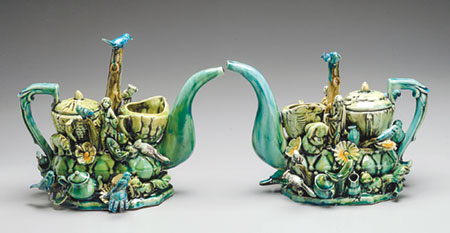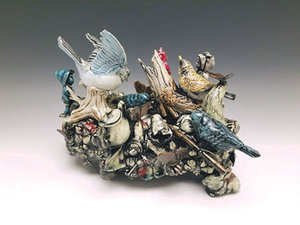Altering reality is accomplished through gradual shifts in perspective. Whether it’s changes in subgroups of society or an individual, those intimately observing the changes aren’t thrown off when considering how point A came to point B. Interestingly enough, those removed from the process still recognize the group or individual as the same entity even though they might see some of the changes as drastic.

When viewed collectively, Craig Clifford’s sculptures capture this slow shift of ideas through his practice and subtle evolutions as an artist, some of them known only to himself. “My ideas are generated just through the process of working and curiosity.” An onlooker might see an explosion of ideas in a standalone piece, but Craig didn’t start there, and getting to that point was accomplished by finding different ways of doing one thing—finding ways to ask the same question in different pieces.
Being able to keep a motif front and center in his mind, Craig never takes a break from reimagining ways to take the piece he’s currently working on and envisioning a new approach. “I might think something as simple as ‘What if I change that to butterflies?’ or ‘What if I took some of that leaf pattern that’s on the base and I added more of that to the vessel itself?’” In some of his pieces, Craig simply imagined the sculpture hanging from the wall rather than sitting on a table.
These explorations in results are made possible through the use of slipcasts, molds that are filled with liquid clay, so he can recreate that object over and over. It’s common when looking at his work to find pieces using the same base, perhaps a cup or vessel, grow into unique versions of one another. Craig can use this technique to duplicate the smaller aspects of his pieces as well. Though some of his molds are purchased, he creates others through more organic means. “I’d go out into nature. I’d find a stick I really like. I would make a mold of that stick, and then I’d be able to use the stick a hundred times.” With a means to turn almost anything into a physical component of his sculptures, inspiration is nearly as abundant as potential figurines.

Roughly four years ago, Craig got it in his head to do something unique to his pieces. It’s pretty subtle, and even those who follow his work might not notice. “Up until that point, I might find the figurine, make a mold of it, and then slipcast that mold over and over again and use it repeatedly. Then I thought ‘Well, why make a mold of that figurine? Why not just use the actual figurine and see what happens?’”
There’s a particular sculpture we discussed involving two roadrunners that were once a figurine. They sit center with a small cactus, their turquoise feathers look almost marble over their whiter beaks and breasts. Along their backs, the feathers mix with in a bit of gray that has the slightest hint of red. Some of the tips of their tail plumage then become sharply red while others have the marble turquoise.
“I’m always interested in the idea of transformation. So with the roadrunners, for instance, they were just a figurine I bought at a thrift store for a dollar. In my mind, at some point somebody owned it and liked it. Either somebody bought a present for their grandparent and gave them this roadrunner, or they bought it on a trip. It meant something to somebody for some period of time, and then they got sick of it and took it to the thrift store, and then I’m taking it and adding more value to it. … I’m transforming it from this object nobody cares about into an object somebody hopefully cares about.”

There’s something inherently poetic about this whole process. Craig changes an aspect of how he approaches his work so discreetly that few would recognize his turning of a figurine long forgotten into something admirable. From the ends to the means, every facet of creation progresses an evolution that Craig’s audience can sense but isn’t necessarily cognizant of.
Aside from the objects that serve as muse and mold, there’s inspiration in each of Craig’s full-time jobs: artist, teacher, and family. His wife, Debbie Kupinsky, is also an artist, and inspires him to do things outside his norm, like making figurines by hand, when they work on a series of pieces together. Visitors of craigcliffordceramics.com can recognize Craig’s exploratory works and the influences they have when he returns to what he’s most comfortable with in slipcasting.
Perhaps it’s teaching that more actively inspires Craig to attack his works with his oft-repeated theme of “curiosity and transformation.” It goes back to when he was attending Orange Coast College in California and took a ceramics class as a break from his primary coursework. “As I was working on the wheel throwing pots and cups and bowls, I would show other people how to do it. … I enjoyed watching them get better.” Add to this his view of the professor having it pretty good making and selling pots and taking summer vacations, and Craig found little reason to pursue otherwise.
Teaching in Louisiana, California, Mississippi, and now at University of Wisconsin–Oshkosh, Craig has 16 years of inspiration under his belt. Looking at his pieces throughout that time makes transformation something tangible. His work lends itself to what it means to go from one idea to the next. Sometimes the amalgamation is additive to his ideas and identities past; sometimes it’s taking everything that’s inspiring Craig in the moment and seeing what happens when they’re put together, often thrust upon one another. All of his explorations make up something universal that his audiences will be familiar with as they struggle to find solace in discovering for themselves just why that is.
-Kyle Jacobson is a copy editor for Madison Essentials, and a writer and beer enthusiast (sometimes all at once) living in Sun Prairie, Wisconsin.
link to the original article in Madison Essentials Magazine
